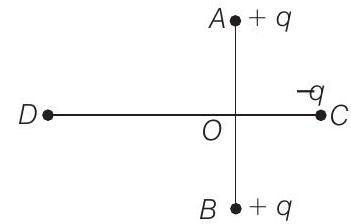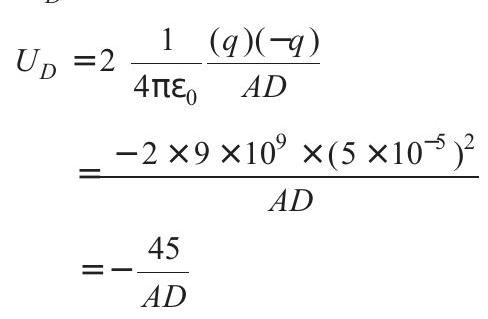Electrostatics 2 Question 29
30. Two fixed, equal, positive charges, each of magnitude $q=5 \times 10^{-5} C$ are located at points $A$ and $B$ separated by a distance of $6 m$. An equal and opposite charge moves towards them along the line $C O D$, the perpendicular bisector of the line $A B$. The moving charge, when reaches the point $C$ at a distance of $4 m$ from $O$, has a kinetic energy of $4 J$. Calculate the distance of the farthest point $D$ which the negative charge will reach before returning towards $C$.
$(1985,6$ M)

Show Answer
Solution:
- Equating the energy of $(-q)$ at $C$ and $D$
$$ \text { Here, } \begin{aligned} K _C+U _C & =K _D+U _D \\ K _C & =4 J \\ U _C & =2 \frac{1}{4 \pi \varepsilon _0} \frac{(q)(-q)}{A C} \\ & =\frac{-2 \times 9 \times 10^{9} \times\left(5 \times 10^{-5}\right)^{2}}{5}=-9 J \end{aligned} $$
$$ \begin{aligned} & K _D=0 \\ & \text { and } \end{aligned} $$

Substituting these values in Eq. (i)
$$ \begin{aligned} \quad 4-9 & =0-\frac{45}{A D} \\ \therefore \quad \quad A D & =9 m \\ \therefore \quad O D & =\sqrt{A D^{2}-O A^{2}} \\ & =\sqrt{(9)^{2}-(3)^{2}} \\ & =\sqrt{81-9}=8.48 m \end{aligned} $$






